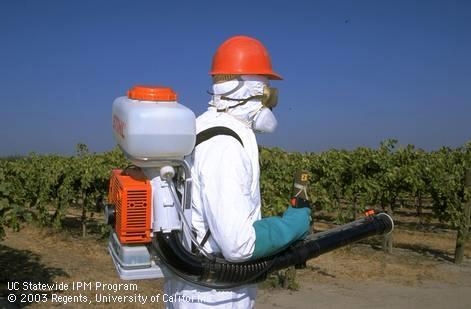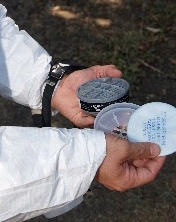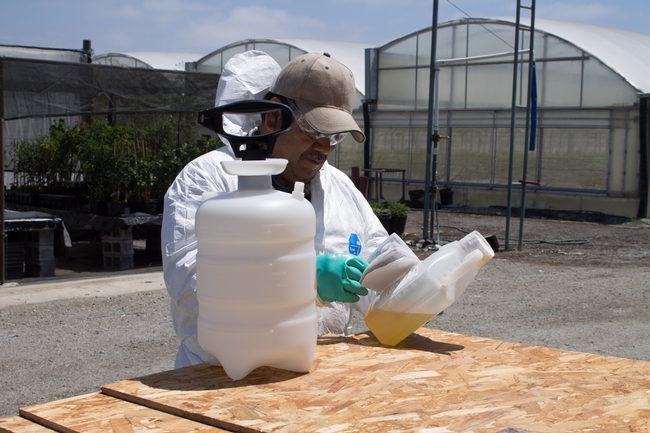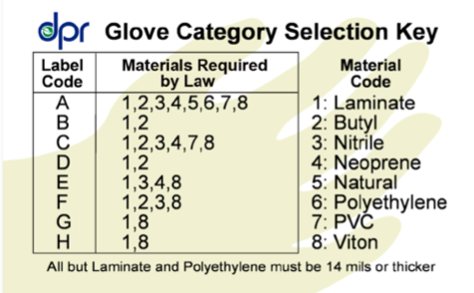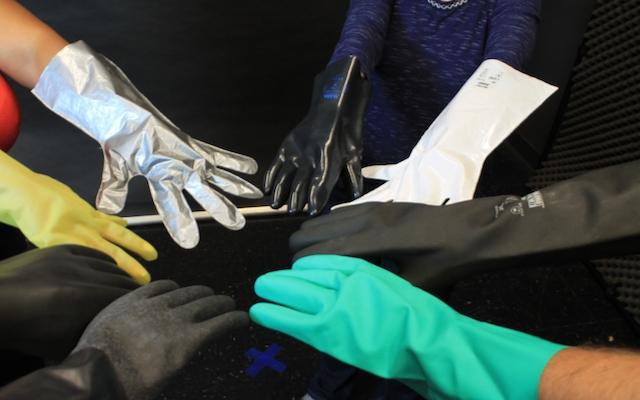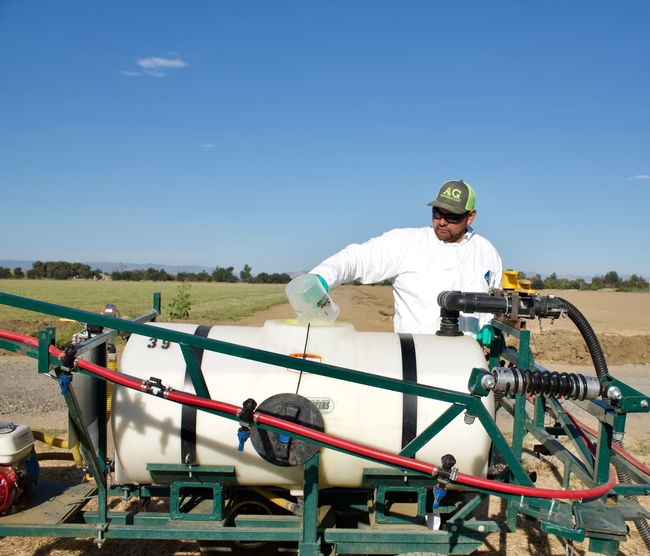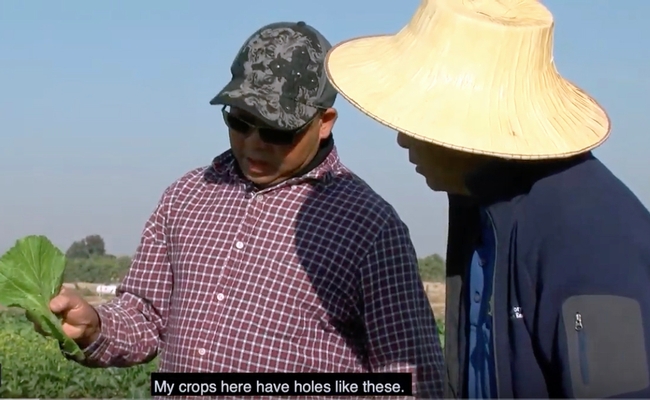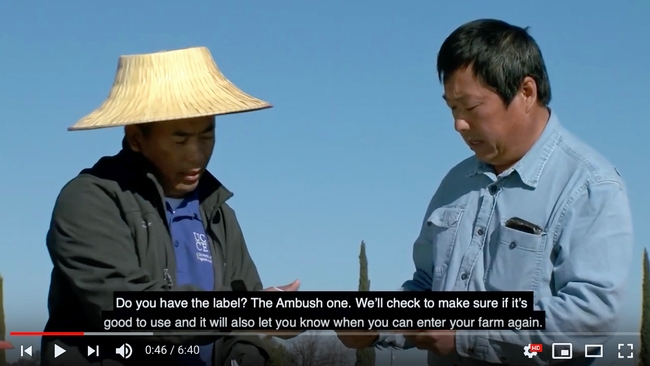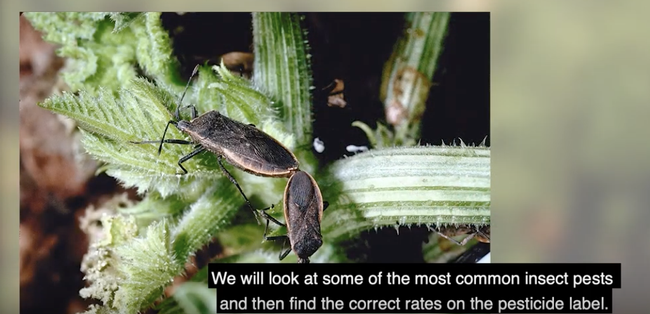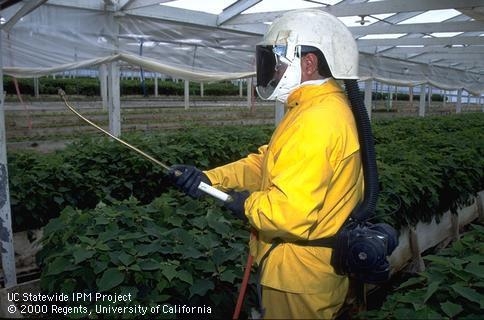Posts Tagged: pesticide
PPE in short supply for farm work during the COVID-19 crisis
Gloves, N95 respirators, coveralls and other gear that workers wear to protect themselves from COVID-19, pesticides, dust and other health hazards are in short supply as priority is given to health care workers during the pandemic.
To reduce the spread of COVID-19, workers may wear homemade face coverings, but for applying pesticides, they must wear respirators specified on the pesticide product label, said Whitney Brim-DeForest, UC Cooperative Extension rice advisor.
Pesticide applicators may use gear that is more protective than required by the product label and regulations.
“Although this could change in the days ahead, half-mask and full-mask respirators are more available than disposable N95 respirators for now,” said Lisa Blecker, coordinator for the UC Pesticide Safety Education Program.
Before the pandemic, 10% of N95 respirators from 3M went to health care, but that number is now 90%, the company said in a letter to distributors. This has led to significant backorders of PPE supplies for distributors.
Carl Atwell, president of Gempler's, an online distributor of worker supplies, said that before the crisis, normal lead times for PPE was up to 10 days. He estimated disposable respirators will become available in the fall and other PPE supplies in August.
In the meantime, there is alternative PPE that agricultural professionals can use during the shortage.
Atwell suggests looking for lesser known brands of PPE as opposed to the first tier of choice: “It's sort of like searching for Purell hand sanitizer. Purell brand might be out of stock, but can you find a different disinfectant?”
On Gempler's website, the more recognizable Tyvek coverall from Dupont is sold out, however disposable protective clothing is available from other brands. Reusable chemical-resistant clothing is also available as opposed to their disposable counterparts. Supplies in high demand are reusable and disposable nitrile gloves, protective clothing, disposable respirators and certain protective eyewear, such as goggles and face shields.
For workers who will be applying pesticides, Blecker and Brim-DeForest offered some guidelines on how to meet PPE requirements as the shortage continues.
General PPE requirements: “Remember, the label is the law,” said Brim-DeForest. “PPE requirements for agriculture are not being loosened.” The UCCE advisor recommends purchasing only what you need for the season and choosing reusable PPE whenever possible. Growers who have excess supplies of PPE can coordinate with their county agricultural commissioner or UCCE advisor to help other producers in their area.
Respirators: If you can't find the respirator required on the label, Blecker said, “Use an alternative, more-protective respirator. For example, if an N95 is required, you can use a half-mask with N95 particulate filters; these can be stand-alone filters or ones that attach to an organic vapor cartridge. You could also use a different pesticide that doesn't require a respirator. Consult with your PCA (pest control adviser) for options.”
Gloves: Chemical-resistant gloves, usually 14 mil or more in thickness are required for most California pesticide applications and should be worn by mixers, handlers and applicators. If nitrile gloves are not available, viton and laminate gloves are universal chemical-resistant materials for most pesticide labels. If the glove material is specified on the label, that instruction must be followed.
“Disposable gloves less than 14 mil can be worn, but not for more than 15 minutes at a time,” Blecker said. “Farmers should also note that thinner gloves cannot be layered on top of one another.”
Coveralls: Coveralls should be worn when required by the pesticide label or when the signal word is “WARNING” or “DANGER,” or when applying by backpack or airblast. “Coveralls can be made out of high-density polyethylene fibers (Tyvek and other brands), which are disposable, or cotton, which are reusable,” Brim-DeForest said. “If reusable coveralls are worn, the employer must ensure employees are provided clean coveralls.”
Goggles/face shields: Face shields are required for mixing and loading pesticides only if it's stated on the label. “If a face shield is unavailable, a full-face respirator can be used,” Blecker said. “Goggles or protective eyewear should always be worn in California when handling pesticides, regardless of what the label says. The face shield, goggles or safety glasses must provide front, side and brow protection and meet the American National Standards Institute Z87.1 standard for impact resistance.
The UC Integrated Pest Management Program also covers these topics in their pesticide safety webinar series at http://ipm.ucanr.edu/IPMPROJECT/workshops.html.
For more information about PPE, contact your county agricultural commissioner or see the California Department of Pesticide Regulation's posters at https://www.cdpr.ca.gov/docs/whs/pdf/gloves_for_pesticide_handling.pdf and https://www.cdpr.ca.gov/docs/whs/pdf/n95_alternatives_for_pesticide_handling.pdf.
Hmong-language pesticide safety videos now online
DPR, Fresno State and UCCE create pesticide safety videos with Hmong farmers
A series of videos describing California pesticide rules and safety in Hmong is now available to view for free online. The videos were produced by California State University, Fresno and UC Cooperative Extension in Fresno County with funding from the California Department of Pesticide Regulation.
The nine-part video series – Complying with Pesticide Laws and Regulations in California – is part of DPR's mission to reach California's farming communities. The videos cover a number of topics including using personal protective equipment, understanding pesticide product labels and application permit requirements.
The innovative educational tool blends peer-to-peer communication with traditional extension methods to include the knowledge and experience of both farmers and extension experts. Hmong farmers featured in the video helped develop scenes in which they educate other farmers, purchase and use personal protective equipment, and interact with extension staff.
“We worked with Hmong farmers who are following pesticide regulations themselves, and are now giving back to educate their peers,” said Ruth Dahlquist-Willard, UC Cooperative Extension small farm advisor, who collaborated on the video production. “Their voices and expertise helped make the scenarios more realistic and accessible to other farmers in the Southeast Asian community.”
Michael Yang, longtime UC Cooperative Extension small farms and specialty crops agricultural assistant, stars in the videos, interacting with farmers based on his extensive experience and trusted relationships in the Hmong farming community, and narrating the educational content in Hmong.
“We hope the videos broaden the reach of our local extension programming to help more farmers understand pesticide regulations and avoid fines, as well as improve their safe handling, selection and use,” said Yang.
Dahlquist-Willard and Yang plan to show the videos at UC Cooperative Extension meetings with Hmong farmers and distribute copies on flashdrives to county Agricultural Commissioner's offices in Fresno County and beyond. The videos are captioned in English.
“DPR works with all types of farmers on pesticide issues and it's critical that they use these tools safely – regardless of the language they speak,” explained DPR Director Val Dolcini. “This video project, the first of its kind to use Hmong speakers, will help foster safer use of pesticides.”
The videos can be viewed at http://bit.ly/fs-dpr-hmong-pesticide-video. The modules in the series cover:
- Introduction to California Pesticide Laws
- Checking for Crops Registered on the Label
- Pests and Application Rates on the Label
- Understanding Signal Words
- Following the Restricted Entry Interval (REI)
- Following the Pre-harvest Interval (PHI)
- Knowing Common Restrictions on the Label
- Using Personal Protective Equipment (PPE)
- Pesticide Permits and Reporting requirements
The project took 700 hours over 18 months to complete, including filming and post-production. Twelve Fresno State students were also involved in producing the videos with the Hmong farmers in Fresno County. Dahlquist-Willard and Yang provided the creative direction in partnership with the farmers involved, and Fresno State's MCJ Multimedia Production Service under Professor Candace Egan brought professional video production and editing skills to make a high-quality finished product. Fresno State student video editor Mali Lee, a fluent Hmong speaker, completed the final edits of the Hmong language material.
“This was one of the most rewarding projects I have ever worked on,” said project director Bill Erysian of Fresno State. “We brought together a unique group of agricultural specialists, students, farmers and video professionals to create a high impact, professional set of educational videos on pesticide compliance for our Hmong farmers here in California.”
DPR has comprehensive pesticide safety and outreach material available in Punjabi, Spanish and English at https://www.cdpr.ca.gov/docs/whs/worker_protection.htm.
UC offers spray application training Sept. 22-23 in Davis
Farmers, pest control advisers, pesticide applicators and others who use agricultural spray equipment are invited to attend an agricultural spray application workshop on Sept. 22 and 23. The two-day workshop, hosted by UC Agriculture and Natural Resources, will be held at the Western Center for Agricultural Equipment at 154 Hills Drive in Davis.
The intensive, hands-on workshop will be led by Ken Giles, professor in the Department of Biological and Agricultural Engineering at UC Davis; Franz Niederholzer, UC ANR Cooperative Extension advisor for Colusa, Sutter and Yuba counties; and Lynn Wunderlich, UC ANR Cooperative Extension advisor for the Central Sierra region.
The UC ANR instructors will train participants to identify the appropriate spray equipment components, practices and conditions necessary to deliver safe and effective agricultural pest control to a particular location, timing and crop.
The workshop will cover nozzles and atomization, the dynamics of drift and how spray droplets move, factors affecting spray deposition, hydraulic nozzle alternatives (electrostatic, air shear, etc.), measuring spray coverage, pumps, sprayer selection, air-assisted spraying and more.
Before the class, to fully prepare, registrants should view a short, online PowerPoint presentation about basic sprayer calibration. A link to the PowerPoint will be sent in the registration confirmation email. A brief quiz on the material will be given at the beginning of class on Sept. 22.
The training is set to begin at 12 noon on Sept. 22, resuming at 8 a.m. on Sept. 23 and end at 2 p.m.
Registration for the training costs $150 until Sept. 12 and $175 after Sept. 12 and can be paid online at the registration website. Onsite registration will cost $200. The organizers have applied for CDPR Continuing Education units.
To register or to get more information, visit http://ucanr.edu/sites/Spray_Application_Training.
Santa Maria farmers and farmworkers assist in UC pesticide-exposure research
A group of Santa Maria farmworkers has volunteered to participate in a UC study to determine whether they are exposed to hazardous pesticide residues when harvesting strawberries.
The study is led by Robert Krieger, UC Cooperative Extension specialist in the Department of Entomology at UC Riverside. Krieger is an expert in environmental and occupational toxicology.
This summer, Krieger and a team of researchers spent nearly three weeks in Santa Maria with workers at DB Specialty Farms. The workers wear gloves as they pick strawberries. Before each break, their gloves are collected and frozen for later lab analysis.
“We’ve found that pesticides are transferred to the gloves during normal work and we’re measuring the amounts that are transferred in hopes that we can use it to measure total exposure,” Krieger said. “The real question is how much exposure occurs, how much is OK, and how little occurs under normal conditions of use.”
The team is also collecting samples of strawberries harvested by the workers and samples of leaves.
In order to understand uptake and excretion, the workers are asked to collect urine for 24-hour periods after working in sprayed fields. To be certain any sign of pesticides in the urine came from work exposure, the researchers have also collected 24-hour urine samples from spouses or roommates of the field workers to assess dietary or home exposure.
“The levels of exposure are determined by how much is applied, how much remains on the crop and how much is transferred to people. We’ve independently measured those and came up with an assessment of how much a person is exposed to during their normal work,” Krieger said.
The research focuses on two pesticides: the organophosphate malathion and the pyrethroid fenpropathrin. After the pesticides are applied, there is a three-day waiting period before harvest gets under way. In the project, as soon as the workers are back in the field, the monitoring begins.
Studies that Krieger has conducted over the past 18 years show that low, safe levels of pesticide are absorbed and rapidly excreted by harvesters. Breakdown products of the pesticides – parts of the pesticide molecule that are not toxic – can be measured in the urine, but it is not known whether the pesticide broke down on the plant, before the workers were exposed, or if the workers’ metabolism broke down the pesticides.
“Those breakdown products are not toxic, but if they are absorbed, they will appear in the urine and we can’t tell whether a plant made it or a person made it and that complicates our analysis and that’s one of the new areas that we’re investigating in 2012,” Krieger said.
By comparing the gloves, fruit, leaves and urine and using sophisticated metabolic chemistry in the laboratory analyses, the researchers will be able to reconstruct how much exposure there was during the work day.
If the research concludes that analyzing gloves is a useful way to measure worker exposure, gloves could become an important tool for farmers and regulators. Another probable area of impact from the study is in verifying the levels of exposure, which the researchers are finding to be very low.
“These workers have very low levels of pesticide exposure. And in fact, they’re the best-studied workers with respect to pesticide exposure in agriculture,” Krieger said. “That gives us confidence that the exposure is not having a health impact.”
Definitive results from the August study are expected in about six months.
The research program has been sponsored by strawberry growers of the California Strawberry Commission and the Personal Chemical Exposure Program, UC Riverside. The current Santa Maria research is possible by the involvement of DB Specialty Farms and Safari Farms of Santa Maria, and PrimusLabs.
The research was approved by the Institutional Review Board of UC Riverside and the California Environmental Protection Agency. All the participation is voluntary and the farmworkers and their spouses or roommates are compensated for the inconvenience of urine collection. They receive $25 for each 24-hour collection and a $100 bonus for completing all 10 urine collections.
In addition to the extra pay, the study volunteers benefit by helping improve pesticide safety for themselves and their colleagues.
“These workers are doing a service to other workers by allowing us to measure the amount of exposure that occurs during normal work,” Krieger said.
View video of the on-farm research below:

